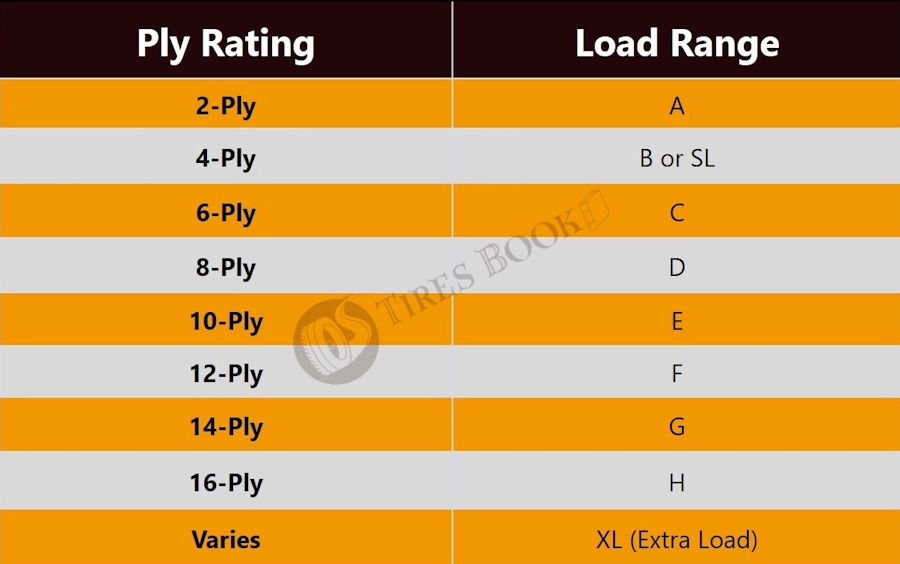What Is Ply Rating?
Ply rating is a measure of a tire’s strength and capacity, originally based on the number of cotton layers in its makeup. Now, it serves as an indication of how heavy-duty a tire is, closely linked to its inflation and load-carrying capacity. For instance, a 6-ply rated tire has a load range of C.
What Is a Tire Ply?
Historically, tire plies constitute cotton fibers that add strength to the tires. Over time, rubberized textile cords replaced these, allowing fewer plies to achieve greater strength. This evolution led to the contemporary ply rating concept, representing a tire’s load-carrying ability when fully inflated.
Tire Ply Rating Chart
The ply rating chart categorizes tires based on their load-carrying capacity:

How to Find Tire Ply Rating and How to Read It?
To find and read a tire’s ply rating, you should examine the tire’s sidewall markings. This information is typically near an alphanumeric code that represents the tire size and specifications. The ply rating is often indicated by a Load Range letter within this code.
For example, consider the tire code: P225/65R17 102H E. In this code:
- P225/65R17 specifies the tire’s dimensions and type.
- 102H is the tire’s load index and speed rating.
- E at the end represents the tire’s Load Range.
The Load Range letter, in this case, ‘E‘, is what you should look for to determine the ply rating. The letter ‘E’ corresponds to a ply rating of 10, indicating the tire’s strength and load-carrying capacity.
Relation Between Tire Ply and Load Rating
The relationship between ply rating and load range in tires is a crucial aspect of understanding tire strength and load capacity. Originally, ply rating referred to the actual number of layers of rubber-coated fabric in the tire. For example, a “6-ply tire” would have six physical layers. However, as tire technology advanced, manufacturers were able to produce tires that delivered the same strength and load capacity with fewer layers.
This evolution led to the introduction of the load range system, which provides a more accurate representation of a tire’s load-carrying capacity and strength without directly referencing the number of plies. The load range system categorizes tires into several classes, each denoted by a letter (like B, C, D, E, etc.). These letters correspond to a tire’s ability to withstand a specified air pressure and carry a certain load, which was historically associated with a certain number of plies.
For instance, a tire with a load range of ‘C’ might be equivalent to what used to be known as a 6-ply tire in terms of strength and load capacity, even though the tire may not have six physical plies. Modern tires might use stronger, more efficient materials that achieve the equivalent load capacity with fewer layers.
How to Choose the Right Ply Rating Tires for Your Need?
Choosing the right ply rating is crucial for safety, performance, and cost-effectiveness. The ply rating indicates the tire’s strength and load capacity.
Choosing a ply rating that is too low can lead to safety risks, reduced fuel efficiency, and shortened tire lifespan. Conversely, a high ply rating can decrease driving comfort, increase fuel consumption, and incur unnecessary costs. Therefore, it’s essential to assess your vehicle’s load requirements and driving conditions to select the appropriate ply rating.
Here is an idea of which ply rating is suitable for which type of vehicle:
- 2 to 4 Ply Rating (Light Load A, B, SL): Suitable for passenger cars, small trailers, and light-duty vehicles. You can use these tires for everyday road use and not for heavy loads.
- 6 Ply Rating (Medium Load – Load Range C): Ideal for heavier passenger cars, minivans, light pickup trucks, and SUVs. These tires are good for vehicles that carry moderate loads or tow small trailers.
- 8 Ply Rating (Heavy Load – Load Range D): Suitable for full-size pickup trucks, vans, and SUVs that are regularly used to tow or carry heavy loads. They offer more stability and durability for heavier vehicles.
- 10 Ply Rating (Extra Heavy Load – Load Range E): Commonly found on heavy-duty pickup trucks, large vans, and some commercial trucks. You can use these tires for vehicles that carry very heavy loads or tow large trailers.
- 12 to 14 Ply Rating (Extreme Heavy Load – Load Range F, G, H, XL): Suitable for large commercial trucks, buses, and trailers. You can use these high-ply rating tires for the heaviest load-carrying capacities. They are not suitable for passenger vehicles.
